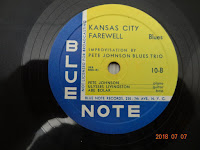Pete Johnson Blues Trio - December 19 1939
Pete Johnson
“Barrelhouse Breakdown” & “Kansas City Farewell” and “Holler Stomp” & “You Don’t Know My Mind,” Blue Note 10 & 12, $1.50 each, both 12 inches
The greatest and most musical boogie pianist lives up to expectations here, appearing in better form on the latter two sides, which are strictly solos. First two show Johnson with Abe Bolar, bass, and Ulysses Livingston, guitar accompanying. Breakdown is fast and not up to Pete’s par. Farewell, a slow blues. Seeps with sincerity and must stand as a truly great performance. Holler is fast, stompy boogie piano while You Don't Know is a non-boogie, slow blues performance. Utterly non-commercial, Johnson's improvisations are breath-taking all the way. This column has long shouted of Johnson’s prowess. It is gratifying to know he is finally beginning to be appreciated and that a firm like Blue Note – which deserves patronage of all musicians and collectors —has the initiative to preserve Johnson’s boogieisms in permanent form.
The American Record Guide – April 1940 – Volume 5 Issue 12
Kansas City Farewell and Barrelhouse Breakdown; Pete Johnson’s Blue Trio, Blue Note No. 10, price $1.50
Vine Street Bustle; and Some Day Blues; Pete Johnson’s Blue Trio, Blue Note No. 11, price $1.50
You Don’t Know My Mind; and Holler Stomp; piano solos by Pete Johnson, Blue Note No. 12, price $1.50
(Personnel of the Trio is: Pete Johnson, piano. Ulvsses Livingston. guitar; and Abe Bolar, bass.)
Blue Note will be the despair of reviewers yet! There is nothing a critic enjoys better than finding a fault to write about. But what fault we find with a single Blue Note issued so far? True, they have not all been of equal quality. There were spots here and there that were not entirely satisfactory. but on the whole, there is sincerity of perceptible in each of the discs issued so far.
The outstanding side in this group is Some Day Blues. First of all it is built around an excellent slow blues theme, and it is played by all with equal fervor. It is one of those themes that could go and on through endless variations without tiring either the players or the listeners. In fact. it ends rather abruptly as if everyone concerned were so engrossed with the music that mechanical limitations were forgotten. The recording is excellent.
Honors are equally divided between Johnson and Livingston, with Bolar lending excellent support.
Second honors go to You Don't Know My Mind which is conceived in much the same mood as Some Day Blues but for a solo instrument. But in spite of its aural and emotional appeal, it is thematically and technically inferior.
Kansas City Farewell is also a slow blues on a good theme but its effect is lost in poorly balanced recording. The piano is too prominent ; the guitar is weakly recorded; and the bass is so badly out of focus that it is hardly more than a blurred boom throughout the disc.
The other three numbers are boogie woogies which are distinguished chiefly by the virtuosity of Pete Johnson, who is a past master with such music. Plenty of vim, vigor, and vitality but not much feeling.
Incidentally, all three discs were made at the same session. Pete Johnson chose his companions, one of whom. Abe Bolar, once played with him years ago in Kansas City honky tonks. Livingston was chosen because of the impression he had made at a jam session at Café Society when Johnson was playing there. All the numbers were unprepared and perfectly spontaneous.
Down Beat – 15 March 1940 – Volume 7 Issue 6
“Some Day Blues” & “Vine Street Bustle,” Blue Note 11, a 12-inch album.
The of last pair of platters (he made six in all) show him in fine fettle. Abe Bolar, bass, and Ulysses Livingston on guitar work more effectively here than they did on Barrelhouse Breakdown and Kansas City Farewell, and Pete's Steinway stylings reveal him at his best on slow blues and a more animated boogie. Bustle jumps nicely while Some Day is more emotional, in slower tempo.
 |
| 661-9 Test Pressing |
Sources and attribution: Dan Morgenstern - Reminiscing At Blue Note - CD-8-28893-2 Richard Cook - Blue Note Records - Secker and Warburg Stanley Dance - Pete Johnson / Earl Hines / Teddy Bunn Sessions - MR1-119 Richard Havers - Uncompromising Expression - Thames and Hudson |














No comments:
Post a Comment